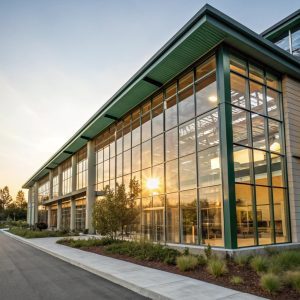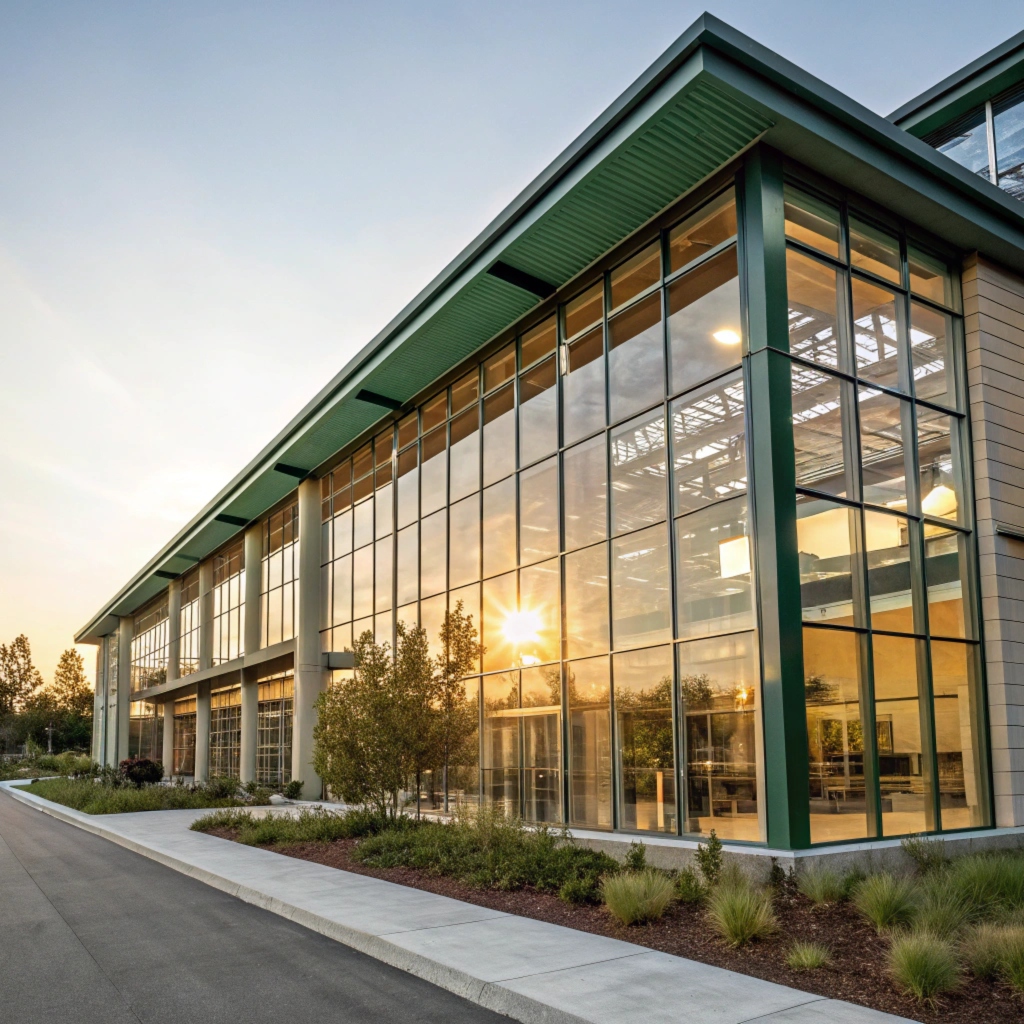
When was the last time you realized your windows were letting sunlight in, yet leaving all that hard-earned warmth outside?
You might not even notice it – but the consequences can be significant. This isn’t about adding any fancy new tech; it’s just a simple swap of glass and frames.
The surprising thing is how much it actually increases natural light and heat inside your home or building, leading to better overall efficiency.
With improved energy conservation, you could potentially save on heating bills by 20-30 percent. What if this simple change helped make your business more efficient too?
How Glass Facades Reflect Light and Heat Patterns
When it comes to building efficiency, one of the most effective ways to boost natural light and thermal energy conservation is through glass facade installation. A well-designed glass facade can have a significant impact on both your home or office’s interior ambiance and its overall performance.
Glass facades allow an abundance of natural light to flood in during the day, making it easier for occupants to work and live comfortably. The transparency of the glazing material enables sunlight to pass through, illuminating spaces that might otherwise be shrouded in darkness. This not only improves mood but also reduces the need for artificial lighting.
In addition to letting more natural light in, glass facades can help keep your space warm during the winter months by reducing heat loss. When a building is well-insulated and energy-efficiently designed, it becomes harder for cold air to seep in through gaps and cracks that might exist around windows or doors. This not only saves you money but also ensures a more comfortable environment.
In terms of how glass facades reflect light and heat patterns, they work by reducing the amount of UV radiation that enters your home or office. By using low-e coatings on the outside surfaces of your building’s facade this will prevent excessive heating during warmer months and reduce cold air leakage in colder months making it a very efficient material choice for many buildings
The Science Behind Thermal Energy Conservation in Buildings
Installing a glass facade has two significant benefits: increasing natural light and enhancing thermal energy conservation. These factors can significantly impact your building’s performance.
Thermal energy conservation involves minimizing heat transfer between two systems that are in contact or have significant differences. In the case of glass facades, it reduces heat flow into and out of buildings which helps save heating costs during winter. For instance, a study by the U.S. Department of Energy found that installing low-e coated windows can reduce energy consumption by up to 30%. This is because these coatings help prevent infrared rays from escaping through the glazing.
A well-designed thermal insulation system is used to keep your home cool when summer comes around. Examples include reflective materials that deflect solar radiation in sunlight, like solar window films or exterior shades. These systems can be particularly effective for buildings with high east-west exposure where direct sunlight can heat up interior spaces during the day.
Infrared and heat gain can be prevented by using low-e glass or tinted glass. For instance, a study published in the Journal of Building Science found that applying an anti-reflective coating to windows reduced indoor temperature when compared to non-coated glass during summer months.
In addition, there are several types of thermal insulation systems available for buildings, including:
- Air barriers: These systems prevent air leaks from entering a building through gaps and cracks in the exterior envelope.
- Insulation materials with high R-values: Materials like fiberglass batts or radiant barrier foams provide significant energy savings by reducing heat transfer between inside and outside.
- Radiative barriers: These systems are designed to reduce solar radiation gain, keeping buildings cooler during summer.
The science behind preventing infrared rays from entering a room through glass is simple. Imagine the sun’s rays hitting a window like a brick wall – most of these rays will simply bounce off without passing into your home. However, some might seep through due to their high temperature and energy content. Low-e coatings or tinted glass help reflect this heat away from your building.
Some popular products for preventing infrared gain include:
- Low-e coated windows: These are available in various types of window glasses and can be applied directly to existing glazing.
- Tinted films: These work by absorbing some of the sun’s rays, reducing solar radiation entry into a room.
Understanding the Benefits of Double Glazed Windows for Natural Lighting

Double-glazed windows minimize heat transfer while allowing sunlight to enter, conserving thermal energy and reducing reliance on artificial lighting. This well-designed window type can significantly improve your living space by providing natural light without sacrificing comfort or energy efficiency.
By installing double-glazed windows in a building design, homeowners can save up to 40% of heating and cooling costs. For instance, a study found that buildings with double-glazed windows had an average annual energy savings of $625 on their utility bills. This not only reduces your carbon footprint but also saves you money on monthly payments.
Double-glazed windows offer several environmental benefits. They help reduce heat loss in winter by minimizing air leaks and insulating the building, thereby conserving thermal energy. Moreover, these windows can significantly improve indoor air quality by reducing pollutants from outside sources.
For a better living space with reduced noise pollution and enhanced comfort, consider consulting an expert in your building design to incorporate double-glazed windows into your project. Furthermore, their aesthetic appeal is also worth mentioning – they add beauty to any room while maintaining energy efficiency.
In addition to the environmental benefits of double-glazed windows, using them can save you money on utility bills. In fact, a study discovered that homeowners with well-insulated buildings saved $1 million in utility costs over 25 years due to proper insulation and window usage. This not only reduces your carbon footprint but also saves you money on monthly payments.
Incorporating double-glazed windows into your building design will allow for an efficient home where occupants can enjoy a comfortable living space without breaking the bank or compromising thermal comfort.
Aiding Architects with Designing Sustainable Green Spaces Using Glass Facade Installation
The type of glass used during Facade installation is critical for achieving optimal thermal performance and reducing heat gain. Low-E glasses, which stand for “low emissivity,” can significantly impact a building’s energy efficiency by reflecting radiant energy rather than absorbing it. This results in keeping buildings cooler in the summer and warmer in the winter.
Low-E glasses work due to their unique properties: they have a low rate of infrared radiation emission (emissivity) that reduces heat gain from solar radiation, allowing more natural light to enter through them while minimizing overheating during warm months. By using these specialized coatings or gas fills inside the glass panes, thermal performance can be substantially improved.
Imagine walking into a modern office building on a sunny day and feeling comfortable despite the warmth outside; this is made possible by well-designed low-E glasses in its facade installation. Double-paned glass windows with these coatings serve as an efficient insulation barrier, maintaining indoor temperatures more stable than single-glazed or uninsulated alternatives.
This technology has been successfully applied to various building types, including residential buildings and commercial complexes. For instance, in a high-rise apartment complex where sunlight is harnessed during the day while reducing heat loss at night; low-E glass significantly reduces energy consumption by minimizing summer solar gains and winter solar losses through its reflective properties.
For example:
- Low E (Emissivity) glasses have been widely used in Scandinavian countries to reduce heat gain, keeping homes cool during hot summers.
- Green Roofs equipped with this technology help keep buildings warmer in cold winters while allowing for natural light throughout the day.
Reducing Maintenance Costs With Smart Glass Technology In Buildings

Boosting Building Efficiency through Smart Glass Technology
One of the most significant advantages of incorporating advanced glass materials into building facades lies in reduced maintenance costs. By minimizing disruptions to indoor climate control systems, property managers can reap substantial benefits.
For instance, a study conducted by a leading architectural firm found that installing smart glass in commercial buildings can save up to 30% on energy consumption. This translates into significant cost savings over time, such as $10,000 per year for an office building with an average annual utility bill of $50 million. By reducing the need for frequent repairs and replacements of traditional shading systems and thermostatic controls, property managers can enjoy substantial financial benefits.
Imagine having to replace a traditional shading system or thermostatic control every 5-7 years due to wear and tear; that’s where smart glass technology comes in. It can help you avoid such costly replacements by reducing the need for manual adjustments. Additionally, incorporating smart glass into building design can minimize repair work during winter months by reducing thermal stress on traditional glazing systems.
Smart glass technology leverages electrochromic materials to change from transparent to opaque or reflective states, allowing light and heat regulation in real-time. This dynamic property enables buildings to optimize their energy efficiency without compromising occupant comfort.
Incorporating smart glass into building design can also lead to reduced glare and UV radiation exposure, creating a healthier indoor environment for occupants. Studies have shown that the use of smart glass can decrease UV radiation levels by up to 75% in urban environments, providing a safer working space.
By harnessing the power of advanced glass materials, property managers can enjoy improved building efficiency, lower energy bills, and increased asset lifespan making it an attractive solution for both new construction projects and retrofits.
Building an Eco-Friendly Environment Through Window Selection
Incorporating double-glazed windows into your building design can have a significant impact on energy efficiency and indoor air quality. A well-lit room is like a happy home – but did you know that natural light has been shown to boost productivity by up to 20%? And, it’s not just about feeling good; research suggests that exposure to natural light can also improve mood by as much as 15%. In fact, studies have found that workers who are exposed to adequate natural light are more than twice as likely to be engaged and focused at work.
For those looking to create a healthy indoor environment for their employees, schools, or families, incorporating double-glazed windows is an excellent starting point. Double glazing has become the new standard in many parts of Europe and North America due to its ability to reduce heat loss during winter months. This means less energy consumption and reduced utility bills – perfect for those looking to save money without compromising on comfort.
Double glazed glass comes in various forms, each with its unique characteristics that set it apart from one another. There are low-e coatings (which work by reflecting radiated infrared radiation) as well as thermal glass (with improved insulation). Thermal insulated windows can further enhance the overall energy efficiency of your building but at a higher cost.
Different glazing materials offer varying levels of performance in terms of energy efficiency, with some being more suitable to certain climates than others. In cold climates such as Scandinavia for instance – double glazed units have been known to significantly reduce heat loss through windows by 40%.
A well-lit room is like a happy home; however it’s not just about the aesthetics when selecting new glass facade installations for your building. The importance of choosing the right type can also lie in how much energy you save on heating bills – especially useful during winter.
Incorporating double-glazed windows into your building design may require some extra upfront investment, but the benefits to both your wallet and work environment are substantial.
Understanding Solar Heat Gain and Shading Devices in Modern Architecture
In commercial buildings, installing high-performance windows can increase natural light by as much as 30% while reducing energy consumption by up to 20%. This is a significant improvement in building performance that can make a real difference in occupant comfort and satisfaction.
Solar Heat Gain occurs when sunlight enters a building directly, warming it up which then requires artificial heating systems to cool the air down before making your home comfortable. One way to mitigate this issue is through reflective glazing techniques like those described by architect Edward Culler, where a thin layer of coating on the glass surface deflects up to 70% of sunlight back outside during peak summer months.
This can be particularly effective in regions with intense sunlight, such as Dubai’s desert climate. For example, building owners have seen a reduction of up to 25% in energy consumption by applying reflective windows. Additionally, studies show that solar shades can reduce cooling costs by as much as $1.50 per square foot.
Shading devices like solar shades are also an effective solution for preventing excessive sunlight from entering through your windows during peak summer months. By using a combination of materials and design elements, you can effectively block out 80-90% of direct sunlight while maintaining natural light levels below the building’s requirements (according to the US Green Building Council).
When selecting shading devices, consider factors like architectural style and material to ensure seamless integration with your building’s aesthetic. For instance, a sleek glass facade in an office building might require more subtle solar shades than one made from rough-hewn wood.
Reflective glazing can reduce solar gain by up to 70% when designed with specific angles and shading devices according to Building Envelope Engineering studies (published). These optimal angles can be achieved through the use of advanced computer simulations, which also help in achieving energy efficiency.
Creating Better Airflow through Ventilation Systems with Double Glazed Windows

Great buildings don’t just have windows, they need them. They need them to let in natural light and keep out the cold.
The installation of glass facade is a significant step forward for building efficiency as it helps maintain optimal indoor temperatures by allowing sunlight to warm up the interior while preventing heat loss through UV rays that are damaging your property’s finishings. This allows you to have more control over how much air flows into your home and keep it running at its best.
A well-designed glass facade installation not only saves money on energy bills but also creates a healthier living environment by providing adequate ventilation, which is necessary for reducing the growth of mold in buildings. The better insulated windows allow less cold air to enter your building during winter while keeping warm air from escaping through UV rays and heat loss that can damage property finishes.
Take action today to revolutionize your home’s efficiency with the installation of double-glazed glass facades, which will lead you towards a healthier living environment at a lower cost.


